Did Pregnancy Ruin Your Body? Here’s How to Get It Back
There’s no other way to put it: giving birth to a new life is both one of the most beautiful and most unforgiving challenges women deal with.
While there’s nothing quite like the joy of creating a life, it takes a tremendous toll—both physical and emotional—on the mother’s part.
The first trimester is usually defined by never-ending fatigue as the body starts working hard to prepare itself to accommodate a new life. Besides sleeping in, you’ll be no stranger to frequent bathroom visits; as your uterus grows in size and pushes on the bladder.
Expect light-headedness. Your body is working after-hours to supply the blood and nutrients for your baby (which means less for the mother.) General exhaustion and trouble eating due to nausea can make the light-headedness worse. Constipation becomes a thing now, too.
As far as the visual changes go, where did those breasts come from?! Most women see a significant increase in breast size disproportionately early in the pregnancy. As the “fatty tissue” inside the breasts is replaced with “milk-producing” tissue, your breast will start feeling soft and swollen. Small bumps might appear underneath the skin.
You will also see changes down below. The expanding waistline designed to accommodate the baby and the growing uterus; the thicker, less sensitive lining around the vagina, accompanied by a thin, white discharge or minimal bleeding.
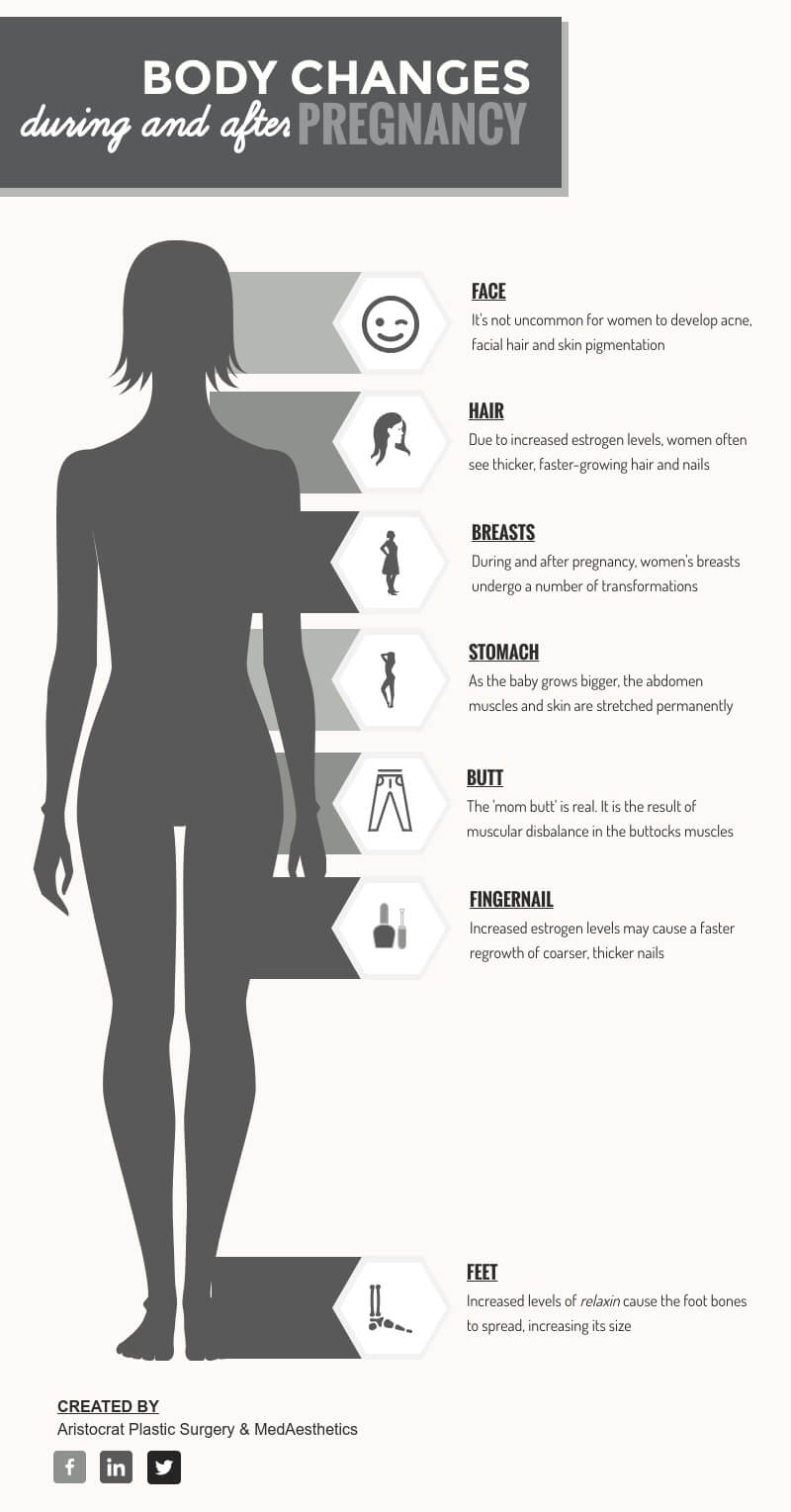
The second trimester—weeks 13 through 26—is a time frame when things calm down slightly, and you feel like yourself again.
During this time, your body is changing at the very core, pushing to the limits. As your growing baby puts pressure on your leg nerves and blood vessels, you might start experiencing aching in your legs.
Your body will start retaining more fluids for the baby and your blood circulation slows down, which can cause a swollen-looking appearance in your ankles, hands and face.
Carrying a growing human bowling ball in your belly is also intense on your back, pelvis and hips. Your back will hurt purely from the stress put on it, but your hips can begin to ache as pregnancy hormones relax the ligaments that hold your bones together.
In regards to visual changes, well, say hello to stretch marks. Not every woman gets stretch marks, but it’s a very common thing that happens as your belly and breasts grow larger. Unfortunately, there is no real way to stop stretch marks completely.
Not only your breasts will continue to grow larger, they will become firmer as well. The skin around the nipple (the areola) will darken. That is your breasts’ way of switching into full “breastfeeding settings.”
—
The third semester—starting week 28—is when your body is taken to absolute, over-the-top extremes to prepare for childbirth and breastfeeding.
Your bones and ligaments will move to prepare you for the process, causing pain in the abdomen area. Cramps and sharp pain become a part of the daily routine.
The fatigue will return, as your body goes back into full preservation mode. Sleep, good food and staying active are a must during this sensitive time.
You might experience heartburn—a persistent burning sensation in your throat. That is because in the last few weeks of pregnancy, your uterus becomes so big it pushes the stomach and its contents back up the throat, causing a consistent burn feeling.
And, of course, there’s the back pain. If the ever-growing baby inside your belly isn’t enough, the pregnancy hormone relaxin loosens your joints to prepare for childbirth, putting even more pressure on your back.
And then—finally—it all ends.
Naturally, a transformation of this intensity and magnitude leaves women with permanent changes.
In the first few days after giving birth, you might feel aching and burning when you urinate. Due to the massive hormonal changes after pregnancy, many women sweat a lot, especially while sleeping.
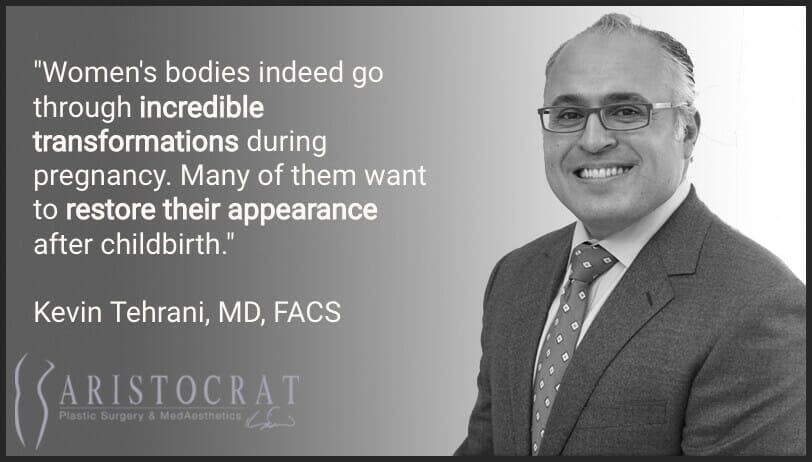
Some time passes, and you’ll be able to re-evaluate your body shape after the journey. Most women notice that the body isn’t exactly the way it used to be before the pregnancy. The breasts look more saggy and smaller. So does the butt. Not the waistline, though: that one’s a clear indication you’ve just had a baby.
In fact, some women still “look pregnant”, even after giving birth, due to the stretching of the abdominal muscles.
Why do So Many Women Get Plastic Surgery after Pregnancy?
Every year, it is becoming more and more popular to go under the knife after carrying a baby. Our guess is that an increasing amount of new mothers have the information of how a surgeon’s knife can help them get their bodies back.
Another reason that could have prompted this is that plastic surgery in itself is becoming more and more acceptable.
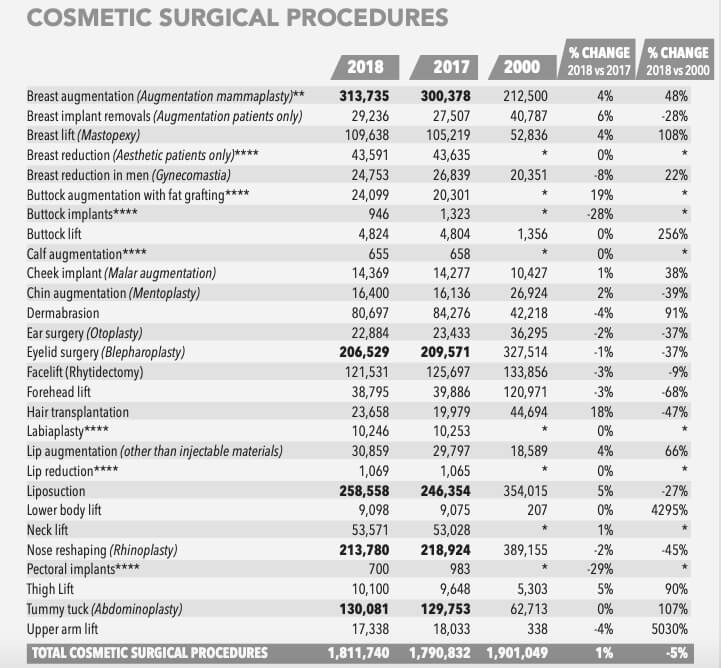
Whatever the reasoning, the numbers don’t lie, as more and more procedures associated with post-pregnancy recovery are performed every year in the US:
- Tummy tuck is considered the most direct and impactful procedures that can help new mothers restore their youthful appearance. According to the American Society of Plastic Surgeons, the number of tummy tuck procedures performed in the United States has spiked by 107% (from 62,713 procedures to 130,081) since 2000, and remains equally popular every year.
- Breast augmentation is frequently chosen by women whose breasts significantly “deflate” after they’re done breastfeeding, hence its ever-high popularity. Compared to year 2000, the number of breast augmentation procedures has risen by 48% in 2018 (from 212,500 to 313,735 annual procedures.)
- Breast lift is a similar procedure to breast augmentation, but provides a larger scope and a more profound impact. The procedure is still relatively new, and its popularity has risen by 256% since year 2000 (from 1,356 annual procedures to 4,824 in 2018)
- Breast reduction is a popular option among mothers who’ve had large, perky breasts even before pregnancy, and who find their breasts sagging downwards after giving birth. The total annual numbers of breast reduction procedures have increased up to more than 43,000 in 2018.
- Liposuction is another common procedure that is instrumental in the overarching “mommy makeover” series. During pregnancy, stubborn pockets of localized fat tend to surface for women, which encourages to add the procedure to the overall list. While lipo was booming in the 2000s, it is still the most popular surgical procedure at more than 250,000 cases each year.
- Vaginal rejuvenation, or labiaplasty, is also a relatively new procedure that new mothers tend to look into. While carrying a baby, the vaginal skin tends to become firmer and less sensitive. Blood vessels can also surface and become increasingly visible near the vagina area. Both in 2017 and 2018, more than 10,000 labiaplasty procedures have been performed by ASPS members in the United States.
Physical Changes Lead to Mental Wellbeing
Now, the obvious reasoning behind why so many women choose to go under the knife after having a baby revolves around physical appearance.
After all, who wouldn’t want to look like their younger, previous self?
But it goes deeper than that. Much deeper.
A major transformation like pregnancy is incredibly challenging. As you very well know, it often leads women into an emotional rollercoaster—a trip that doesn’t always end on a high note.
What exactly causes a condition called postpartum depression? According to Andrea Chisholm, MD, a contributor to the Harvard Health Blog, we don’t really know.
But it’s not that difficult to guess.
Hormonal Changes During and After Pregnancy
During pregnancy, women experience a number of hormonal swings to adjust their body for a new life. After giving birth, another big change occurs, preparing them for breastfeeding and motherhood.
When women get pregnant, their estrogen levels start increasing gradually. The amount of estrogen in a woman’s body peaks during the third trimester, but have an active role in the second trimester, too (responsible for formation of the milk duct—breast enlargement.) In the first trimester, a quick surge in estrogen often causes vomiting and nausea.
While estrogen is mostly responsible for nutrient delivery and a successful transition to breastfeeding, progesterone—another female hormone—is what causes actual physical changes in women, such as:
- Laxity or loosening of the ligaments and joints in the body
- Increase in size of the uterus (the place where a baby grows up, normally no larger than a small pear) and other internal structures
Overall, these two hormones ensure the safe development of the fetus. Some call these two the “chief pregnancy hormones”:
- Increase blood circulation that is often referred to as the “pregnancy glow”
- Make sure the baby receives all the nutrients he/she needs
- Change the internal structure of your body to accommodate the baby and prepare for labor
While this process is totally natural, it does affect the mother’s moods.
Estrogen, for example, is “intimately related” to serotonin, a chemical in our bodies that “helps us feel at peace and happy.” When estrogen levels drop, serotonin—or, happiness—levels also go down.
Progesterone, as science is just beginning to unravel, is also linked to our “happiness.” Namely, it interacts with a chemical called GABA, a neurotransmitter that blocks impulses between nerve cells in the brain—which keeps us calm and relaxed. When GABA levels drop, anxiety and mood disorders kick in, along with chronic pain.
If you were wondering, those processes are exactly why some women act the way they act during PMS (Premenstrual Syndrome). You do not want to mess with the hormones.
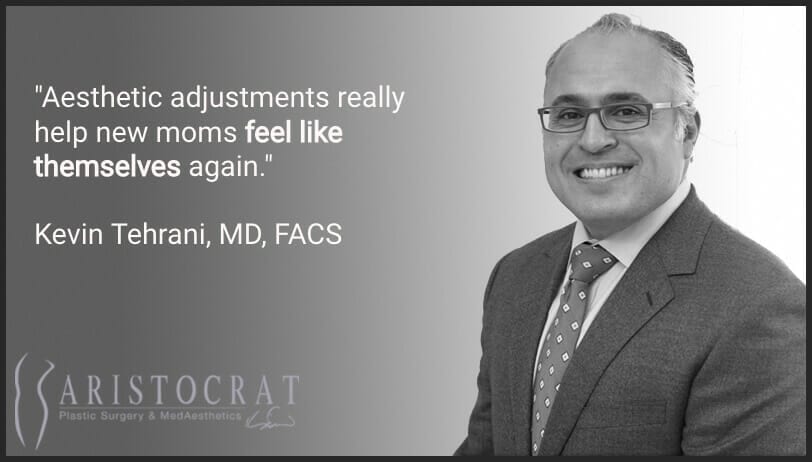
Physical Discomfort
Both during and after pregnancy, women experience a bunch of irritating discomforts.
During pregnancy:
- About 50% of all women experience nausea—and, sometimes, vomiting—also known as the morning sickness, during the first trimester. This is mostly your body reacting to increasing levels of estrogen.
- Due to your body working hard trying to “provide a nourishing environment” for the baby, many women feel tired and even exhausted during the first trimester.
- Hemorrhoids sometimes occur as a consequence of increased pressure on the rectum and the perineum. An increase in blood volume can also cause severe constipation. This usually occurs in the third semester, right before childbirth.
- Heartburn is also a common effect of an increased uterus (where the baby grows.) Basically, a non-pregnant woman has a uterus smaller than her fist. Hormone progesterone helps a pregnant woman accommodate the baby inside her uterus. As the baby grows, the uterus starts pushing more and more onto the stomach, forcing some of its contents back up, causing a burning sensation in the throat.
- Nose congestion is also a common “side effect” of pregnancy. Due to an overall increased blood volume in pregnant women, the respiratory tract receives more blood, forcing the nose to be more congested.
After giving birth, it’s no walk in the park either:
- Back pains very frequently haunt new mothers for weeks after childbirth. While carrying the baby in your belly, your entire posture realigns with your growing shape. Your spinal bones realign. Often times, they will put pressure on a nerve, causing severe back pains.
- Vaginal discharge is another common thing that new mothers are often unprepared for. The liquid itself is called lochia, and is basically blood mixed with material from the uterine lining that supported the baby in the womb. At first, the color is usually red, which then turns to pink, then brown, while gradually becoming more transparent. After 8 weeks of childbirth, the discharge usually stops. While common and natural, it is not exactly a pleasant experience.
- Uterine cramping is also common for women, especially for those who’ve had several children. The aching indicates your uterus returning to its original, pre-pregnancy size.
- Constipation is frequently observed for new moms. It can last anywhere form a few days to a couple of weeks, and definitely doesn’t help to lighten the mood.
Emotional Rollercoaster
Previously described physical and hormonal changes add onto the numerous responsibilities and lifestyle changes new mothers encounter.
For around 15% of women, this can spiral into a series of emotional challenges.
Feeling down the first week after childbirth is completely normal—the condition is kindly called the “baby blues.” Around 80 percent of women experience crying, sudden irritation, anxiety and unexpected mood changes.
For Kimberly Zapata, who kindly shared her postpartum story online, these emotional states transitioned beyond the first week. They were as confusing as they were… natural.
“I cried not because I was sad or lonely or lost (all of which were also true), but I cried because I couldn’t help it”- Kimberly wrote. “It was instinctual, like a cough or a sneeze, and the tears came in torrents: three, four, five times a day.”
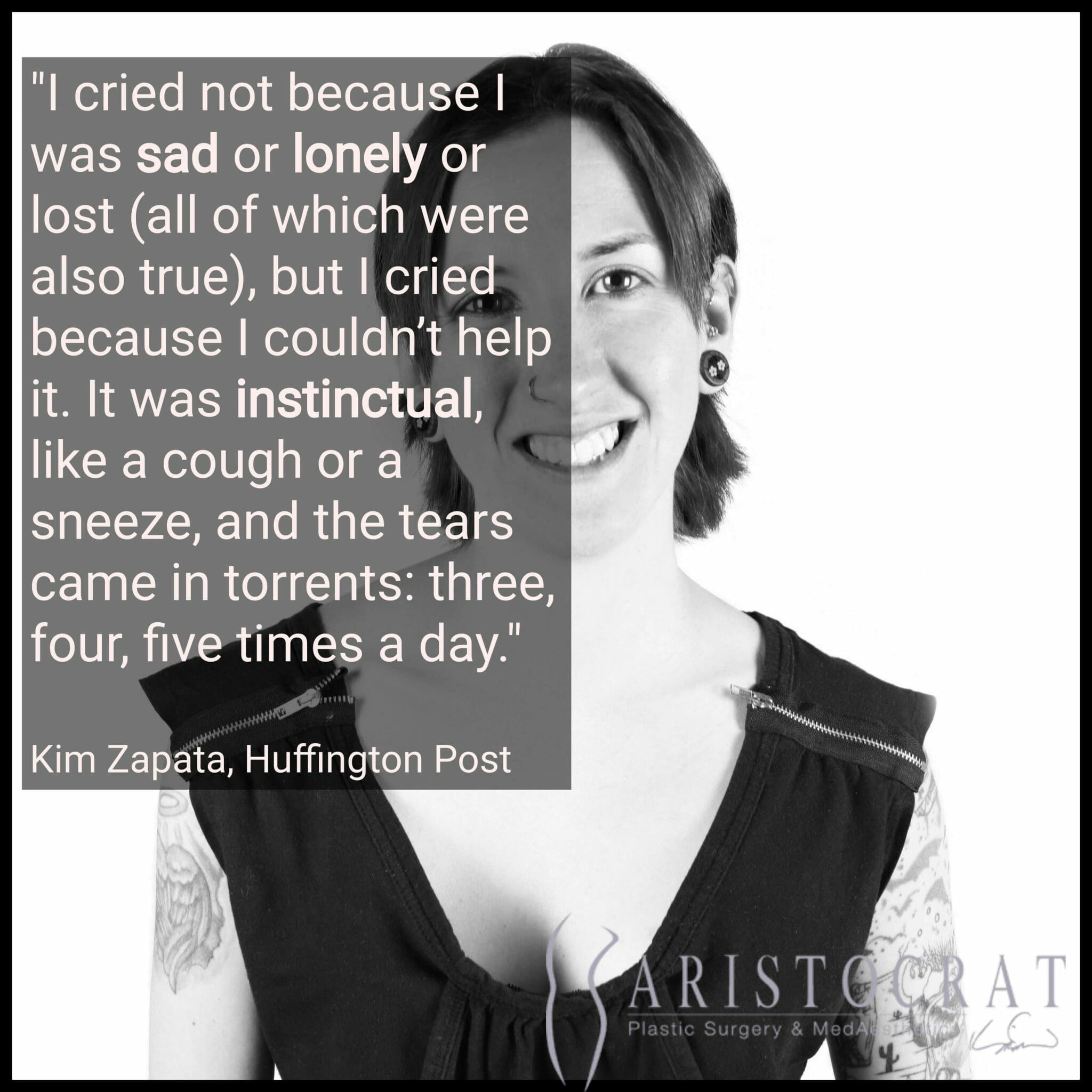
Most new mothers will also go through a period of adjustment. A new set of responsibilities dictates an entirely new, selfless lifestyle—a lifestyle not every young woman is prepared for. Even though the last months of pregnancy already keep most mothers homebound most of the time, caring for another human being takes the job a level further.
For some women, this means dealing with inner anxiety and other mental challenges. In her postpartum story, Elaine Jacobson describes how things got systematically out of control after giving birth to her child:
“Adam was there for me, but it was a very busy time at his job, so he couldn’t stay at the hospital. Though I knew the nurses were there to help take care of Vivian, I couldn’t shake my increasing anxiety”- Elaine describes her feelings after having difficulty breastfeeding her firstborn.
“When we brought Vivian home, the stress got worse. I quit taking care of myself. I didn’t feel worthy – in my mind, taking care of myself meant taking time away from Vivian,” Elaine continues. “I was crying more than I wasn’t.” she concludes.
—
Juli Williams, another new mom who shared her story online, presents another vivid example of how the smallest of things can be the match in a stressed out, hormone-induced mind of a new mom:
“After my baby turned three months, we packed our things and made trek. However, in that time we hadn’t found a place to live and so we had to stay with my parents until then. Right before our trip I got hit with mastitis. I was stressed out (to say the least), and from that moment I started to feel completely overwhelmed by everything that was going on.”
Juli also describes what is called an attachment problem, when a new mom struggles to feel the emotional connection with the newborn.
“And most of it had to do with my new baby,” Williams writes. “I started feeling stressed out every time he cried, which was often. We had just been removed from our cozy environment into a completely different one and we were both feeling the change. I started to really hate breastfeeding.”
It is also worth noting that Juli’s emotional turmoil surfaced only months after childbirth, after a couple of months of smooth sailing.
“In my mind postpartum depression (PPD) only applied to women right after birth, and I had such a beautiful time those first two months that I completely threw the idea out the window.” Williams said.
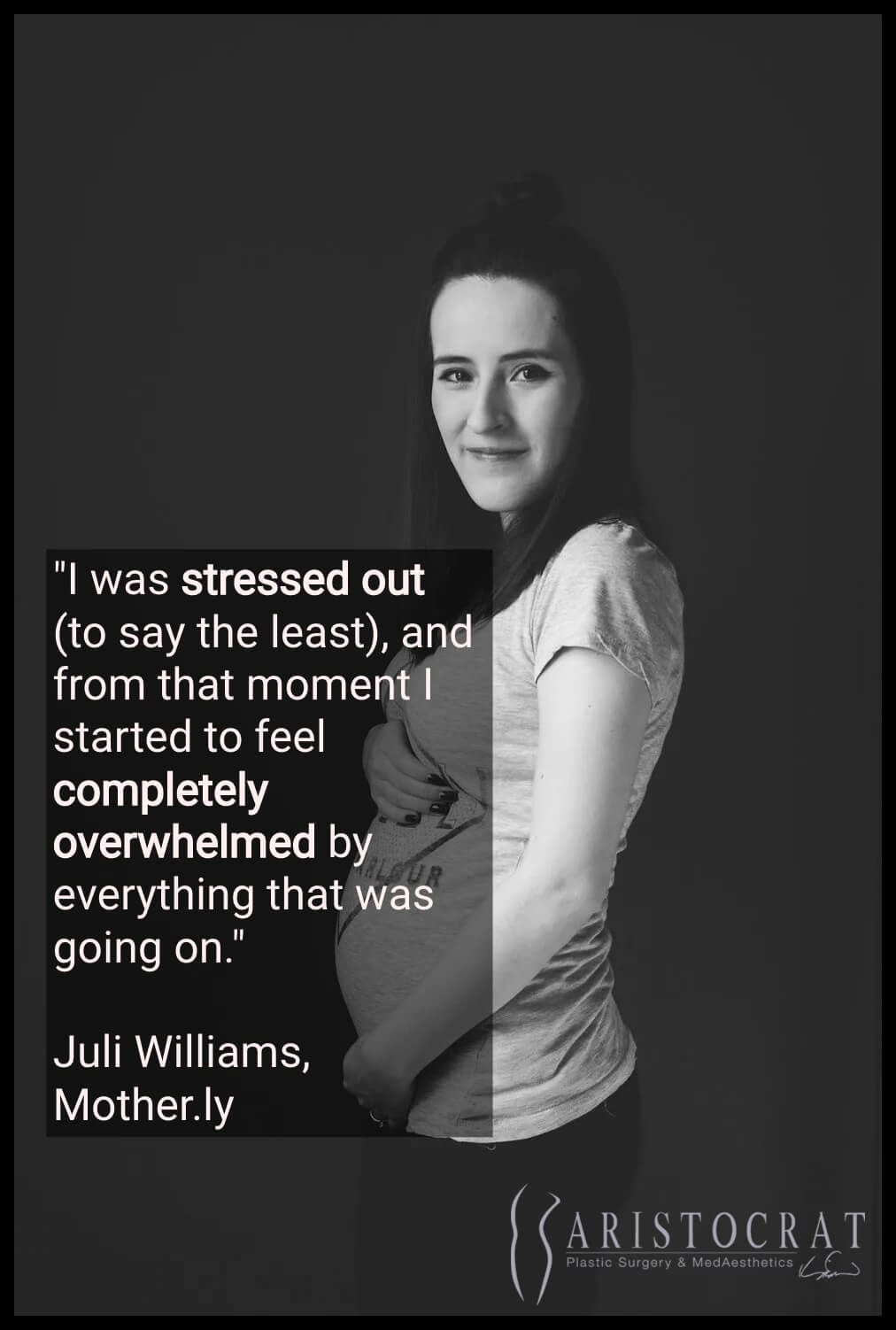
These women must not be judged.
While, in clinical terms, no more than 15% of women experience postpartum depression, many more are struggling with various standalone emotional symptoms.
It must also be mentioned that many women simply do not reach out for help.
As Emily Sisco, a certified nurse-midwife in Obstetrics and Gynecology at Mayo Clinic Health System, summarized the whole process:
“It’s kind of a perfect storm,” Sisco says. “Even if it’s welcome and exciting, adding a baby to the family — be it your first or your fifth — is a major life change. Then there are hormone changes and changes to your daily life pattern. Sleep deprivation is a big one.”
I Get It, Pregnancy Is Hard. But How Is Plastic Surgery the Solution?
Plastic and cosmetic surgical adjustments are by no means the silver bullet. It is not the ultimate answer to the challenges new moms face.
However, it can help you feel more like yourself again.
While physical appearance isn’t the be-all-end-all for all moms, it is important. All women want to smile to their reflection in the mirror.
Plastic surgery can help you achieve just that. Straighten up and lift your breasts; pop some junk back into the trunk; get rid of those love handles; tuck your waistline back where it belongs.
And do not for a moment think that you are alone in this: according to the American Society of Plastic Surgeons, as many as 62% of mothers seek plastic surgery to get their pre-pregnancy bodies back.
Why are they doing it? The reasoning is fairly simple:
- Most pregnancy changes are here to stay. Sure, your hormones will settle down. Your breasts will deflate. But some things won’t go back to ‘normal.’ Breast sagginess, for example, will occur largely due to overstretching of the skin around the breast. Abdomen muscles, too, are severely stretched while carrying a baby. As for the ‘mom butt’, bad news: it occurs due to muscular disbalances in the buttocks area. These changes will barely react to diet and exercise, if at all.
- It helps you feel better. At a time of confusion and turmoil, even a small victory can help you take back control of your life. Such is the power of cosmetic adjustments: they help you feel better about yourself. New mothers don’t do this for others—they do it to increase their emotional wellbeing.
- More women are realizing there’s no shame in it. Let’s be honest: cosmetic adjustments get an unfairly bad rep. If more people realized that there’s nothing wrong with going under the knife to improve the quality of your life, there would be no need for an article like this one. When in qualified hands, plastic surgery and cosmetic adjustments are an act of self-improvement, not self-destruction. Don’t let a few bad apples spoil the bunch, even if they steal the spotlight.
When Is a Good Time to Get Your Body Back?
So the general consensus—one that we strongly support here at Aristocrat—is that women should wait at least 6 (six) months after childbirth before considering plastic and cosmetic adjustments.
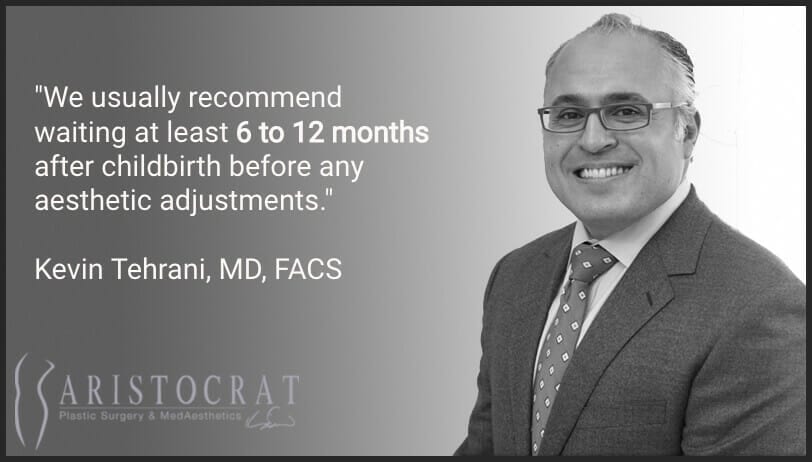
The major reason why waiting at least six months is important is because after the pregnancy, your body needs time to recover naturally. Many of the transformational processes that have occurred during the child-bearing period will start scaling back after childbirth, and operating earlier is simply illogical, let alone unsafe.
But there are other considerations as well.
One of such considerations is caring for your baby and adjusting for the new reality. All invasive procedures will require at least 3-5 days of recovery, during which your ability to look after your baby might be limited.
Not only this can be extremely inconvenient, it can also do more harm than good to your emotional wellbeing.
Best to start considering plastic surgery procedures after things stabilize a bit: both within your body and with your daily routine.
Important Note from Dr. Tehrani: “It’s best to have plastic surgery after you’re done having children. If you’re planning to have children in the nearest future, it might make sense to wait with the cosmetic adjustments until that time. Otherwise, a new pregnancy may simply cancel out the results of your plastic surgery. Not the best use of your time and money.”
How Your Body Changes Through Pregnancy, and How Plastic Surgery Can Help You Get It Back
Now that we’ve covered the “why”, we can start looking into the “what” and the “how.”
1. Face and Skin. What’s That On My Face?
Facial “side effects” of pregnancy definitely aren’t the worst that can happen to a new mom, and the procedures aren’t normally considered a part of the “mommy makeover” program.
However, these symptoms often cause great discomfort for women, making them conscious of their appearance. Sometimes, they don’t go away even months after childbirth. Luckily, there are many lightweight, non-invasive cosmetic procedures that can help you tackle these changes with dramatic efficiency.
Swelling (Face, Nose, Eyelids)
Few people know that pregnant women actually produce 50% more blood and body fluids; such is the body’s way of making sure the baby gets all the nutrients he/she needs.
For the mother, however, this means visible swelling in the facial area, including the nose and the eyelids. Arms are also subject to significant swelling.
While the swelling usually goes away after childbirth, sometimes it doesn’t fade entirely. Since the extra fluids represent around 25% of the weight gained during pregnancy, it can significantly affect your overall appearance.
Solution to swelling: Lymphatic massage
One of the best natural ways of dealing with the swelling is through a lymphatic massage, also known as the manual lymphatic drainage.
During the procedure, the masseur shunts the fluid buildups underneath the skin towards the body’s “natural exit points”, usually in the form of sweat or urine.
A number of studies show various positive effects of lymphatic massage, from an instant cleanse and relief to long-term health benefits.
It has actually been scientifically proven that lymph drainage can help pregnant women and new moms get rid of the swelling, too.
Varicose (Spider) Veins
During pregnancy, women’s blood circulation slows down, while the overall blood and general body fluid volume increases by around 50%. A combination of these factors often causes blood vessels to surface and become more visible, a condition known as varicose—or spider—veins.
Veins usually become more pronounced on the legs and face, however they can also appear in the vaginal area.
By definition, varicose veins are not harmful—it’s a symptom of the natural processes happening in the pregnant woman’s body, not a disorder in itself.
However, this can be discomforting.
For one, varicose veins do not exactly add to your appearance. Many women find spider veins irritating and non-aesthetic.
Surfaced blood vessels can also cause itching and irritation on the surface of the skin.
Varicose veins usually form during the second trimester, and fade away gradually 2-4 months after childbirth. However, in some cases, they do remain visible for years on, forcing women to seek out cosmetic solutions.
Solutions to varicose veins: Sclerotherapy, laser treatment
Sclerotherapy is the name of varicose veins treatment, and is the most effective treatment for vascular damage. The procedure is non-invasive and the results are instant, though individual results may vary. There is minimal discomfort and no down time. Any area on face and body can be treated.
In the regular spider vein treatment, sclerosing solution is injected into each spider vein, causing the vein to collapse and fade from view. Although everyone is different, one injection for every inch of spider vein is generally expected. Bright light and magnification may be used to ensure maximum precision while the skin is held taut to inject sclerosing solution. A cotton ball and compression tape is often applied to each injection site as it is finished.
—
Laser treatment for varicose veins is also available at our clinic.
During the treatment, a powerful laser beam is aimed at the spider vein, dissolving it from underneath.
However, some women experience increased skin sensitivity after childbirth, which makes them a suboptimal candidate for the laser treatment.
Acne
A breakout of pimples is fairly common for new moms—even those who’ve never suffered from acne before.
In general, acne is caused by hormonal changes in your body. That is exactly why so many teens suffer from pimples on their face. An increase in hormones called androgens can cause the glands in your skin to grow and produce more sebum — an oily, waxy substance. This oil can clog pores and lead to bacteria, inflammation, and breakouts.
Women’s bodies also tend to significantly swell during pregnancy. Pimples could also represent some of the fluids and tissue particles, trying to escape your body.
Normally, acne can last anywhere from a few weeks to a few months. Sometimes, however, it just doesn’t seem to go away.
Solutions to acne: natural remedies, over-the-counter medicine, prescription medicine
Acne is one of the lightest post-pregnancy challenges women face, and, for most women, simple over-the-counter medicine will suffice.
Here at Aristocrat, we offer a number of over-the-counter skincare solutions for pregnant women dealing with acne.
Facial Hair
For most women, estrogen levels decrease gradually after childbirth.
However, when the female hormone levels remain high even after giving birth, female bodies start using enzyme to transform estrogen into testosterone.
This, naturally, can lead to a breakout of facial hair in women.
Solutions: Laser hair removal
Unless you enjoy shaving, a few sessions of laser hair removal will help you get rid of the newly found facial hair once and for all.
During the procedure, the laser targets the very root of the hair, “chopping it down” right at the root. The hair then proceeds to fall out over the course of next few days.
Patients with brightest skin and dark, coarse hair are the best candidates for the procedure.
Usually, it takes several sessions to cover the entire area fully, and the effects often last for more than a year.
However, keep in mind that many women experience increased skin sensitivity during and after pregnancy. This can both make the procedure a little more uncomfortable and the recovery longer. Make sure to always consult with your aesthetician whether you’d be a good candidate for the laser treatment.
Melasma (Dark Spots, Pigmentation)
Often called “the mask of pregnancy”, melasma is a common condition after childbirth.
Most frequently, it manifests as a wave of dark spots on the face, nose, forehead, chin and cheeks. Even a small amount of sun exposure can make these dark spots significantly more visible.
It is not fully understood what causes the pigmentation to surface. At this point, the medical community’s best guess is that it’s a combination of hormonal changes and sunlight or heat exposure that causes the facial skin to change color in pregnant women.
Melasma is not a dangerous disorder. However, it can be aesthetically unpleasing.
Solutions to melasma: Chemical peel, laser skin resurfacing
The most important thing for women with melasma is to take proactive measures and protect the skin from sunlight and heat exposure. If you’re going to the beach, make sure to use a strong suncream. Summer hats and big shades are also a must during summertime.
However, just protecting the skin won’t fully fix the problem—not before the skin naturally regenerates, that is.
If you’re looking for a “here and now” solution, we have a couple of options for you.
The best thing we offer women with melasma is a series of chemical peels. During the procedures, an acidic substance is placed onto the skin and removed, along with a thin layer of old, darkened skin, giving way to new, unaffected layers.
Laser skin resurfacing works in a similar way, with the key difference being the technology used. Unlike a chemical peel, which uses acidic formulas to remove the surface layers of dead skin, a laser technology uses, well, a laser to do the same thing.
Once again, we’d like to remind that all laser treatments might not be the optimal choice for women who’ve undergone pregnancy due to increased skin sensitivity.
2. Breasts. Where Did They Go?
Breasts are the primary instrument of motherhood. As such, they undergo a number of transformations during and after pregnancy.
As soon as in the first trimester, a woman’s breasts start growing. This is the result of milk-producing tissue forming underneath the skin.
Along with increase in size, there are a number of other changes that occur in the breast area during pregnancy:
- Breast skin becomes increasingly sensitive and tender
- The area around the nipple—areola—becomes darker
- Nipples tend to stick out and grow in size
- Veins might stick out around the breast, becoming visible
A few days after childbirth, the breasts reach their “ultimate form” to make sure you’re ready for the baby. During this time, they grow even larger, reaching the point of “engorgement.” The increase in size can reach a point where it hurts.
This causes an immense amount of stretching.
The first line of defence, is, naturally, the skin above the inframammary fold (where the bottom of the breast connects with chest tissue.) The stretching of this magnitude can leave highly visible stretch marks, while altering the skin texture and laxity for good.
However, the stretching can also affect your chest ligaments, whose job is to “connect” the breasts to the rest of the body. Precisely due to the stretching of ligaments post-pregnancy breasts become saggy.
Overstretching of the breast tissue can also cause sharp or chronic pain in the chest cavity.
—
From a cosmetic standpoint, most women are happy with their breasts during pregnancy. Wouldn’t it be a better world if they stayed that way?
Unfortunately, they don’t. Around the 15 month mark—or when you stop breastfeeding—the breasts usually start scaling back to their previous size and shape.
All would be good, except that the ligaments and the skin are already stretched. A combination of sagginess and reduction in size often creates the impression of “deflated” breasts.
Our bodies have natural processes to restore some of their “primetime” looks. Namely, the fatty tissue will slowly start replacing the milk-producing tissue, creating a fuller appearance, partially restoring the breasts to their pre-pregnancy looks.
However, the stretching and sagging is there to stay. Post-pregnancy breasts almost never fully go back to their previous appearance, which encourages women to look for surgical options.
Solution to sagging breasts #1: Breast Augmentation (Implants)
Breast augmentation is considered one of the less-invasive surgical options to improve the breast appearance after pregnancy.
During the procedure, an incision is made in the breast and a silicone (or saline) implant is placed between the breast tissue and the skin. While there aren’t substantial differences between the two types of implants for the patients, silicone implants have a slight edge in terms of texture and appearance for many surgeons.
Breast implants usually last for 10+ years without rupturing, but often times patients carry on with for more than 20 years without experiencing any problems with their implants.
The best candidate for breast augmentation after pregnancy will:
- Have no to minimal skin stretching and breast sagginess
- Be looking to restore their breast volume after pregnancy
- Are discouraged by breast lift scars
Solution to sagging breasts #2: Breast Lift
Compared to breast augmentation, breast lift procedures are usually of larger scope. They will require a larger incision, and longer recovery downtime (1-2 weeks.)
What happens during a breast lift procedure?
Unlike breast augmentation, a breast lift will actually remove a portion of the stretched out skin, creating a tighter, more forward-pointing appearance.
Some breast tissue may also be reshaped to create a more aesthetically pleasing appearance.
After the procedure, patients can expect a number of improvements:
- Tighter breasts with significantly less sagging
- The nipples return from downward position back into the “middle” of the breasts
- Stretch marks and the stretched out skin is removed
The best candidate for a breast lift procedure is someone who:
- Has small to moderate-sized breasts
- Has significant skin stretching and breast sagging
- Whose nipples have “moved” to the bottom of the breast after pregnancy
Solution to sagging breasts #3: Breast Reduction
For women with large breasts and significant, over-the-top sagging, a breast reduction may provide the biggest results.
A breast reduction is a similar procedure to a breast lift. Incisions will be made into the breast are, excess skin removed, and some breast tissue will be removed via liposuction.
A big reason why women choose to have breast reduction is due to health concerns, such as aching back, headaches, inability to breastfeed and nerve pain in the neck and shoulder areas.
The ideal candidate for breast reduction is someone who:
- Has large breasts
- Has excessive amounts of sagging, to a point of physical discomfort
3. Belly. Am I Still Pregnant?
One of the most-affected areas during pregnancy is the abdomen—or stomach—area.
While the excess swelling usually fades within 6 months of childbirth, carrying a human bowling ball inside your belly for 9 months severely stretches out the abdomen muscles—a condition which is very difficult to restore only with exercise and dieting (some doctors consider it impossible.)
The stretching of the abs happens naturally—as a result of a growing uterus. However, this often leads to the appearance of still being pregnant, even after childbirth.
Luckily, there are several procedures that address the abdomen area specifically.
Solutions to abdomen stretching: Tummy Tuck, Liposuction
Tummy tuck—also known as abdominoplasty—is the number-one procedure for new moms. It is the key element of the entire mommy makeover program.
During the tummy tuck procedure, a number of important reconstructive processes are performed:
- An incision is made horizontally in the stomach area (doctors make it easy to hide under a swimsuit)
- Fat tissue is removed from the abdomen area
- Abdomen muscles are tightened to restore the flat, youthful appearance
- Excess skin is removed so that you don’t end up with folds of fat
Tummy tuck is a large-scope procedure, and will require 1-2 weeks of downtime before you return to work. However, most new mothers are extremely satisfied with the dramatic results the tummy tuck procedure can provide.
—
During the tummy tuck procedure, many surgeons also like to throw liposuction into the mix.
Unlike tummy tuck, whose main job is to tackle large, distributed fat and tighten the muscles to provide a dramatic change, liposuction procedures are most effective with small, localized deposits of “stubborn” fat.
Liposuction is most effective with issues such as love handles, double chin problems, underarm fat and other local fat deposits that do not respond to diet or exercise.
It is very rare that liposuction alone can provide the level of change expected by a new mom. For that to happen, the woman needs to be happy with her overall appearance and only have small bulges of fat that she wants removed.
The contrary, however, is almost always true: whenever a tummy tuck procedure is performed, it is very common to use liposuction as an additional sculpting tool as well.
4. Butt. Is This How It’s Going to Look Now?
The ‘mom butt’ is no myth: it’s a very real thing that happens to new moms.
The reason why so many new moms seek out surgical options for the appearance of their hips and buttocks is because these body parts are altered profoundly during pregnancy, which means that it’s really difficult to restore them to their pre-pregnancy shape with diet and exercise alone.
See, the appearance of inwardly tucked in buttocks is caused by a number of things, including:
- Muscular disbalances
- Hormonal changes
- Posture changes during pregnancy
The backside of a woman’s muscles becomes overstretched, while the front end of the buttocks becomes tense and firm, causing an imbalanced, tucked-in look.
Solution to ‘mom butt’: Buttocks Augmentation
Also known as the Brazilian Butt Lift (BBL) or Buttocks Enhancement, this is a crucial part of the mommy makeover for most women.
Basically, there are two ways how the buttocks can be enhanced: through implantation or fat grafting.
Implantation means that a silicone (or saline) implant will be placed into the buttocks area.
Fat grafting means that some fat will be removed from another problematic body area (e.g. thighs or stomach) and surgically placed into the buttocks area, creating a fuller appearance.
Often times, a combination of both techniques is used to achieve the desired outcome.
Final Verdict: There’s No Shame In Getting Your Body Back
Pregnancy is a tough time, and it doesn’t get much easier after childbirth.
Don’t let the society dictate how you should feel about your body and your decisions. If you feel like you’re not satisfied with your new shape, and that neither diets nor exercise are helping, do not hesitate to contact us and we’ll help you find a way.
In this article we outlined popular surgical procedures new moms frequently go for, but keep in mind that every patient is unique, and you might be recommended a completely different set of procedures to achieve your goals.
At the end of the day, the tight cooperation with a surgeon you trust will provide the best results.

